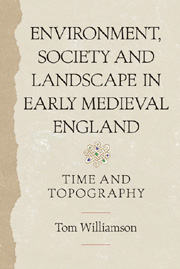Book contents
- Frontmatter
- Contents
- List of Illustrations
- Acknowledgements
- Introduction
- 1 Settlement and Society
- 2 Nature's Frame
- 3 Culture, Ethnicity and Topography
- 4 Small Shires, Deep Roots
- 5 The Gradient of Freedom
- 6 Two Countrysides?
- 7 Village, Farm and Field
- 8 Landscape and Settlement
- 9 Woodland and Pasture
- Conclusion: Time and Topography
- Bibliography
- Index
- ANGLO-SAXON STUDIES
1 - Settlement and Society
Published online by Cambridge University Press: 05 April 2013
- Frontmatter
- Contents
- List of Illustrations
- Acknowledgements
- Introduction
- 1 Settlement and Society
- 2 Nature's Frame
- 3 Culture, Ethnicity and Topography
- 4 Small Shires, Deep Roots
- 5 The Gradient of Freedom
- 6 Two Countrysides?
- 7 Village, Farm and Field
- 8 Landscape and Settlement
- 9 Woodland and Pasture
- Conclusion: Time and Topography
- Bibliography
- Index
- ANGLO-SAXON STUDIES
Summary
Introduction
Historians, archaeologists and others have suggested a number of key social, economic and technological developments which may have had a determining influence on the emergence of regional variations in the English landscape, and English society, during the early Middle Ages – in the period, roughly, between the fifth and the twelfth centuries. Invasions of people from the Continent, in the fifth and sixth centuries and again in the ninth, may have introduced new customs, social institutions and forms of territorial organisation to particular parts of the country, leading (for example) to different kinds of manorial organisation, or inheritance practices, in Kent or East Anglia. In addition, variations over time and space in population growth have always, and probably correctly, been seen as a major influence on the development of different kinds of landscape in England, although most agree that demography cannot be understood in isolation from technical and agrarian developments, which themselves arguably had a direct and determining influence on the character of settlement and field systems. Related to population change, although never in a very direct manner, was the emergence of successive modes of territorial and political organisation, which at a local level have likewise been implicated in the evolution of fields, settlements and land-use patterns by a number of historians. The purpose of this chapter is to briefly examine some of these suggested influences on the development, over time and space, of social institutions and landscapes.
- Type
- Chapter
- Information
- Environment, Society and Landscape in Early Medieval EnglandTime and Topography, pp. 6 - 35Publisher: Boydell & BrewerPrint publication year: 2012



